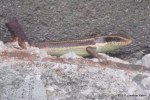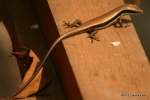Eutropis longicaudata

|
|
|
|
|
English name: Long-tailed Sun Skink
Scientific name: Eutropis longicaudata (Formerly Mabuya longicaudata)
Thai name: Ching-laen Hang Ya
Description: To 50 cm long. Snout to base of tail is up to 14 cm. A smooth, slender lizard with an extremely long tail. Brown with a wide dark brown to black stripe on each side thinly bordered with white or cream. Head is no wider than body and narrows to the nose. Black body stripe continues on head up to eye. Tail is extremely long, over twice as long as the body. If the skink has lost its original tail, the regenerated tail may be no longer than its body. Underbelly is cream to yellow, sometimes with a greenish tint.
Similar Species: Common Sun Skink is not as slender, has a shorter tail, and rarely has as distinct a body stripe.
Speckled Forest Skink is smaller, has a shorter tail, and has a less distinct body stripe.
Habitat: Naturally found in open forest or shrubland, but can live in empty lots near human habitations. Is often found above the ground in trees, shrubs, and walls.
Place in the ecosystem: Eats insects and worms. Occasionally eats plant material like fruit, seeds, and leaves. Can be eaten by large snakes and some birds of prey.
Danger to humans: Will bite when handled and can draw blood, but is not dangerous.
Conservation status and threats: Is a widespread species and is not currently facing population declines. However, a recent study has shown that the Long-tailed Sun Skink may have more difficulty reproducing in urban environments as temperatures rise due to climate change.
Interesting facts: Long-tailed Sun Skinks have been shown to exhibit some “parental care” of their eggs. This behavior, which has been observed in dozens of snakes, lizards, and crocodilians, involves staying with the eggs until they hatch. In the case of Long-tailed Sun Skinks, they appear to stay with the eggs in order to defend them from potential predators, especially egg-eating snakes.
References:
Hong Kong University: Eutropis longicaudata
Ecological Characteristics of the Skink, Mabuya longicaudata, on a Tropical East Asian Island
Parental care in the long-tailed skink, Mabuya longicaudata, on a tropical Asian Island
Orchid Island skinks impacted by global warming
A Photographic Guide to Snakes and Other Reptiles of Peninsular Malaysia, Singapore and Thailand
A Field Guide to the Reptiles of South-East Asia
Hong Kong Amphibians and Reptiles (2nd Edition)









Thanks for this! Helped me identify a photo I took earlier today! 🙂 almost trod on the little bugger!
helped me with my homework!
great!
We live in an Apartment on the second floor, we had Long-tailed Sun Skink hanging out on the porch, wife says get him gone. so i chased him off with a broom, made sure he went clear to the ground, and thought he was gone that was yesterday. I go out on the porch today and there he was looking at me. Is it common for lizards to move in on you like that, we have 2 Tokay Geckos that come in at night and call me until i come out and say hi to them. This one I am going to have to capture and drive away I think.
Yes, many lizards have their own personal territory they try to find, and they try to stick to their territory. This skink probably got driven out of his territory by another skink, or his territory was destroyed by development, or it just didn’t have enough food there. So he has tried to claim a new territory on your window. Long-tailed Sun Skinks especially seem to like those higher vantage points. If he finds enough food there, he might want to stay, but if you keep chasing him off them I think there is a good chance he will choose to go away and find another place on his own.